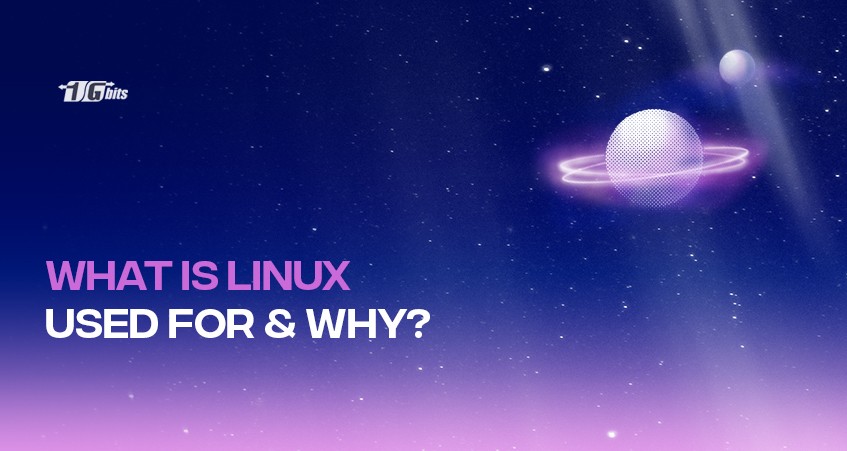What is Linux used for? Linux is a free and open-source operating system (OS). An operating system is a program that controls the hardware and resources of a computer, such as the CPU, memory, and storage. The operating system lies between programs and hardware, connecting all of your apps to the machine’s physical resources. The name is patented by Linus Torvalds, the creator of Linux. The source code is licensed under the GPLv2 license, owned by several of Linux's independent developers.
What is Linux and its Function?
Linux was created to be similar to UNIX and has grown to run a wide range of hardware, including phones and supercomputers. The Linux kernel (which handles hardware resources) and several software packages that make up the rest of the operating system is included with any Linux-based OS. Some organizations or individuals, mainly members of the Free Software Foundation, prefer to call this package GNU/Linux since many essential tools are GNU modules. However, not all Linux configurations have GNU components in the operating system: Android, for example, runs on a Linux kernel but depends on GNU software sparingly.
Many common core modules, such as the GNU tools, are included in Linux OS. These programs allow users to monitor the kernel's resources, install external applications, adjust performance and security settings, and more. Various Linux distributions may have various software configurations since Linux is an open-source platform.
Linux is an open-source operating system that is easily accessible, and it can power devices like computers and smartphones. The term "open-source" refers to software that anyone can use for free.
Its accessibility has encouraged much application and system developers to use it. Linux is an operating system that resides on top of all other applications on a computer, accepting requests from other programs and relaying those requests to the computer's hardware.
For those curious about specific Linux distributions, Debian Linux is a popular and versatile choice. Learn more about its features and benefits in our detailed guide on What is Linux Debian.
What Distinguishes Linux from Other Operating Systems?
Linux is equivalent to other popular operating systems that you might have already used, such as Windows and macOS (formerly OS X). Like most operating systems, Linux provides a graphical user interface and the same kinds of applications you're used to, such as text processors, picture editors, and media players. In certain instances, the developer of an application could have created a Linux version of the same application that you use on other platforms.
However, Linux also differs from other operating systems in many aspects. The source code for Linux is open-source and free to download, update, and modify. Linux is also unique because the main components of the Linux operating system are widely available. Also, several Linux distributions are available, each having its own set of features.
Why use Linux?
Here are a few good reasons for using Linux:
-
High Levels of Security
Linux is designed while keeping maximum security in mind and is highly resistant to virus attacks, malware, ransomware, etc. Many developers have examined the code from the world and have eliminated many of its possible security vulnerabilities. Linux security is one of the main reasons for it being popular amongst developers.
Programs cannot change the system configurations until the user logs in as root and permits them to do so. Since most users don't log in as root, they won't harm the device aside from their files and applications. Also, the downloaded file/malware would only have restricted rights. However, users should install ClamAV antivirus software on their Linux systems to further strengthen the security. For a seamless and secure browsing experience on Linux, check out our guide on the best browsers for Linux.
-
Easy Maintenance
The Linux operating system is easy to maintain since the user can quickly update the operating system and installed applications from a single location. Every Linux distribution has its central software repository, ensuring that the system is up to date and safe. Linux is very good at using the system's power. Users and basic hardware specifications are catered to easily in a Linux installation. The installation process is very modular, allowing users to select the modules to be installed.
Users can update their data regularly with only a few taps or even automate the process. In comparison to a Linux system, updating a Windows system is more difficult. Whereas in Windows, all third-party applications such as Acrobat Reader and Firefox are to be updated individually.
-
Runs on Any Device
We all know that with each new Windows OS update, a large number of hardware systems become outdated because their technological requirements are no longer sufficient to run the most recent Windows OS. Many of the devices you currently own run Linux, including Android phones and laptops, Chromebooks, portable storage devices, personal video recorders, smartphones, wearables, and more. Linux is running under the hood of your car. As part of the Windows Subsystem for Linux, Microsoft Windows also includes Linux elements.
Linux is suited to many electronic devices, ranging from supercomputers to wristwatches. Installing a lightweight Linux distribution on your old system will breathe new life into it, and you can also use a Linux distribution to run a NAS or video streamer.
-
Free and Open Source Software
The most critical feature of Linux is that its source code is freely available as it is free and open-source software (FOSS). It supports the development community because members can access and change the source code, which is not the case for proprietary software.
Users don't have to pay any amount to use Linux. Interestingly, Linux supports a wide range of educational applications and professional applications for photo capturing, audio and video editing, and many more. For those who want to monitor system performance in real-time, Linux offers powerful tools like the watch command, which simplifies the process of tracking changes in command output over time.
-
Usability
Linux has evolved into a user-friendly operating system with an appealing graphical user interface (GUI). It has nearly all of the features that you would find on Windows OS.
If you want to use any programs that are only available for Windows, then install Wine for running those applications on your Linux system. Despite the popular belief that Linux is not a gamer's platform, many games are now available for Linux. If a game is not available for Linux, you can use PlayOnLinux to run Windows games.
-
Personalization and Learning
Users have a lot of freedom in customizing their Linux system to meet their needs. There are over a half-dozen different desktop environments to pick from, including GNOME, KDE, and others. Around four to six options are available for each software, ranging from the graphical user interface and managers to burners and browsers.
If you're interested in using GNOME as your desktop environment, check out our guide on how to install GNOME GUI on CentOS 7 for a step-by-step tutorial to get started.
Almost all the popular web browsers are available for Linux. Also, Linux acts as a great instructional platform for schools and universities. Computational software, such as MATLAB, is extremely costly; Scilab and GNU Octave are two available alternatives. There's Celestia and Stellarium; for chemistry, there's Avogadro and Gabedit; for biology, there's EMBOSS and TreeView X; and for physics, there's ROOT, Octopus, and Step.
-
Assistance
Linux has a large online community that is active across numerous forums. Any question asked in a forum will almost always get a prompt answer. Many volunteers are always ready to help users solve their issues because they are passionate about Linux.
Uses Of Linux
After defining what the Linux operating system is all about, the next step is to include relatable examples that demonstrate the usage of Linux. The Linux operating system can be mounted on various devices and used for various applications discussed below.
-
Games
The gaming industry is constantly improving, with new and improved games launching now and then. You’ll be amazed to know that Linux has already been used to build the gaming engines for some of the top-rated titles.
Did you know? Linux is also a fantastic platform for running classic and modern games through game emulators. If you're interested, check out our guide on Linux game emulators to explore how Linux can bring your favorite games to life!
-
Mainframes and Servers
One of the most popular applications of Linux is to power servers and mainframes. Any business must satisfy the need to protect its data from malicious third parties daily. As a result, servers that ensure full information protection are needed. Linux systems are the least vulnerable to external attacks, allowing for the introduction of reliable data protection measures that improve a company's resistance to hacking and cyberattacks.
-
Communication
The embedded computers used in the telecommunications industry are an outstanding example of Linux uses. Due to the ease with which Linux is customized, Linux is built on most network hardware. Linux networks increase subscriber access and ensure better delivery of network transmissions. A network's knowledge is protected from unknown systems by installing Linux firewalls.
Linux is also widely employed in hosting environments due to its reliability and performance. For businesses or individuals seeking high-performance servers, Linux Dedicated Servers provide an excellent solution, offering unmatched customization and security for managing critical workloads.
Conclusion
Thanks to the open-source license, Linux is freely available to everyone. We hope that this blog post was able to answer the question what is Linux used for? Both businesses and individuals choose Linux because it is reliable, flexible, and supported by a huge community of users and large organizations such as Red Hat. An open-source web server software called "Apache" is currently used to manage almost 60% of the websites on the Internet, and it usually runs on Linux systems. Also, Linux is ideal for storing large datasets of data because it is reliable, safe, and durable. Many tens, hundreds, or even thousands of Linux systems are used to perform some specific operations, such as weather prediction, mechanics modelling, and digital design production. You can also buy linux server to practice it on a routine basis.
People also read:










